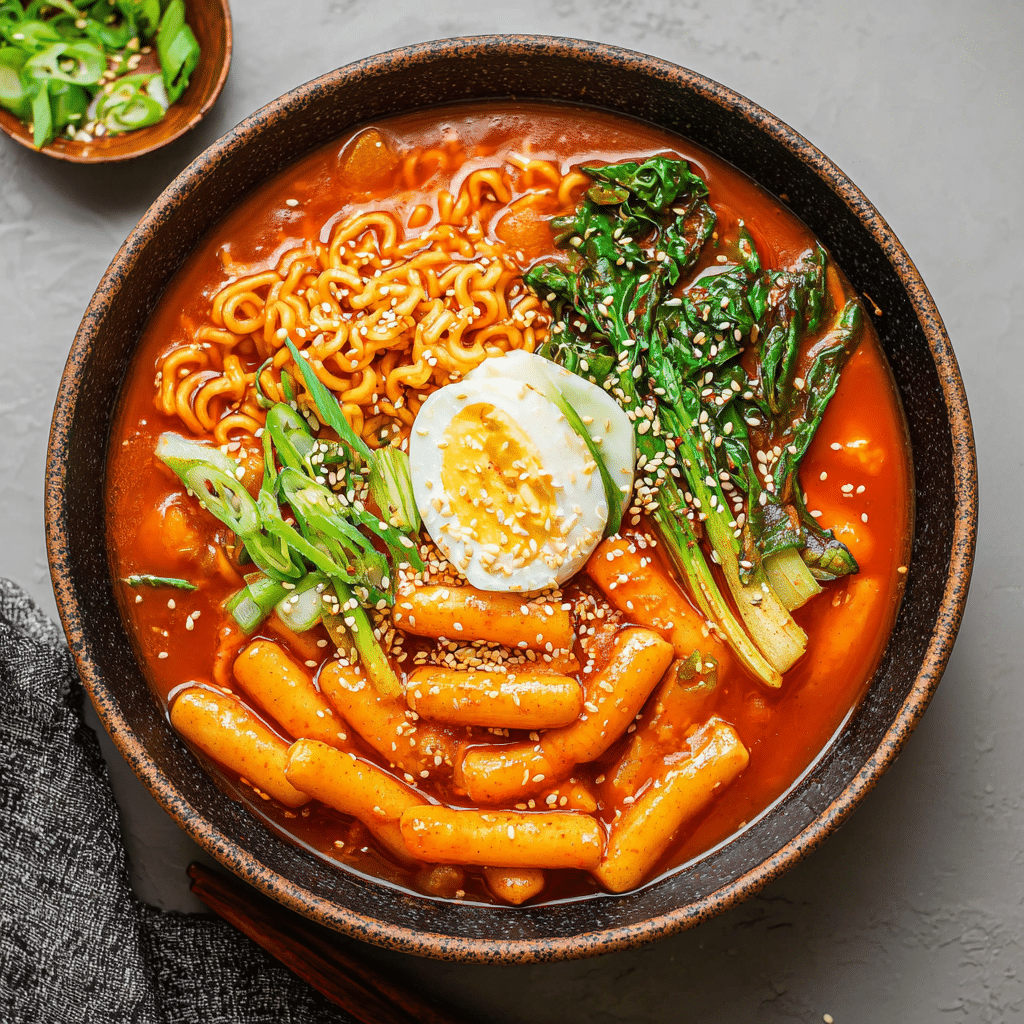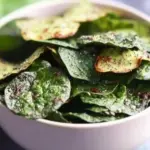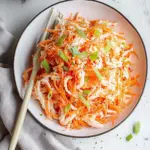The bold, spicy flavors of Rabokki combine the chewy satisfaction of Korean rice cakes with the slurp-worthy comfort of instant ramen noodles. Gochujang and gochugaru deliver that classic Korean heat, balanced with sweet and savory undertones that deepen with every bite.
Perfect for weeknight dinners or late-night cravings, Rabokki is a soul-warming dish that comes together quickly in one pot. It’s highly customizable—add mushrooms, tofu, or greens to make it heartier. This dish is a celebration of Korea’s beloved street food, right at home.
Full Recipe
Ingredients:
-
1 tablespoon sesame oil
-
2 cloves garlic, minced
-
3 cups water
-
2 tablespoons gochujang (Korean red pepper paste)
-
1 tablespoon gochugaru (Korean red pepper flakes)
-
2 tablespoons soy sauce
-
1 tablespoon sugar
-
1 teaspoon mushroom seasoning or MSG (optional)
-
1/2 teaspoon black pepper
-
1/2 cup cabbage, chopped
-
1 green onion, chopped
-
1/2 cup enoki mushrooms (or any mushrooms of choice)
-
1 package instant ramen noodles (vegan if desired)
-
1 1/2 cups Korean rice cakes (tteok), soaked in warm water for 15 minutes
-
1 sheet fried tofu or 1/2 cup tofu puffs (optional)
-
1 teaspoon toasted sesame seeds (for garnish)
-
1 boiled egg (optional for non-vegan version)
Directions:
-
In a large saucepan or skillet, heat the sesame oil over medium heat. Add garlic and sauté for 30 seconds until fragrant.
-
Pour in water and stir in gochujang, gochugaru, soy sauce, sugar, mushroom seasoning (if using), and black pepper. Bring to a boil.
-
Add the rice cakes to the broth and cook for 7–8 minutes, stirring frequently to prevent sticking.
-
Once rice cakes are soft and the sauce is slightly thickened, add the cabbage, green onion, mushrooms, and tofu (if using). Simmer for 2–3 minutes.
-
Add the ramen noodles and cook until noodles are tender, about 3–4 minutes. Stir to coat everything in the spicy sauce.
-
Transfer to bowls and garnish with sesame seeds and a boiled egg if desired. Serve hot.
Prep Time: 10 minutes | Cooking Time: 15 minutes | Total Time: 25 minutes
Kcal: 420 kcal | Servings: 2 servings
Introduction to Rabokki: A Korean Street Food Classic
Rabokki is a beloved Korean dish that perfectly blends two popular street foods—tteokbokki and ramyeon (ramen). Tteokbokki features chewy rice cakes cooked in a spicy, slightly sweet sauce made primarily with gochujang (Korean chili paste), while ramyeon consists of quick-cooking noodles commonly enjoyed as a comfort food across Korea. When combined, these two ingredients create Rabokki, a flavorful and hearty fusion dish that offers the best of both worlds: the satisfying chewiness of rice cakes alongside the slurp-worthy texture of noodles, all enveloped in a bold, spicy sauce.
The Cultural Significance of Rabokki
In South Korea, street food is a vibrant and integral part of everyday life. Rabokki is often found in food stalls, night markets, and casual eateries where it is served piping hot as a snack or a light meal. The dish is especially popular among young people due to its affordable price, quick preparation, and addictive flavor profile. Rabokki also reflects Korea’s culinary creativity—transforming simple ingredients into a complex and delightful dish.
This fusion of rice cakes and ramen noodles has become a modern classic and a comfort food staple that evokes nostalgia and community for many Koreans. It’s the kind of food that brings people together, whether sharing it with friends on a chilly evening or enjoying it solo after a long day.
Flavor Profile and Ingredients: Why Rabokki Stands Out
What makes Rabokki truly special is its balance of flavors and textures. The spicy sauce is the star, usually made with gochujang, gochugaru (red chili flakes), soy sauce, sugar, garlic, and sometimes a touch of mushroom seasoning for depth. This combination creates a complex flavor that is spicy, savory, slightly sweet, and umami-rich.
The rice cakes (tteok) provide a chewy, satisfying bite that contrasts beautifully with the soft, springy ramen noodles. Adding ingredients like cabbage, green onions, mushrooms, and tofu not only enhances the nutritional value but also adds freshness and texture variation to the dish. A sprinkle of sesame seeds and optional boiled eggs add a finishing touch of richness and visual appeal.
How to Customize Rabokki for Different Diets and Preferences
One of Rabokki’s great advantages is its versatility. It’s naturally vegan if you avoid eggs and use vegan ramen noodles, making it perfect for plant-based diets. You can easily adjust the spice level by tweaking the amount of gochujang and chili flakes to suit your palate, from mildly spicy to fiery hot.
For those who want more protein, adding tofu puffs or fried tofu gives the dish a lovely texture and extra sustenance. You can also incorporate other vegetables like carrots, spinach, or bell peppers for additional color and nutrients. For a non-vegan option, adding boiled eggs or fish cakes (odeng) is common in Korea, though these can be omitted for a fully plant-based version.
Cooking Tips and Techniques for Perfect Rabokki
Making Rabokki is straightforward, but a few tips can elevate your cooking experience. Soaking the rice cakes in warm water before cooking ensures they soften properly and don’t become too tough. Cooking the rice cakes and noodles directly in the sauce allows them to absorb maximum flavor.
Stirring frequently prevents sticking and helps develop a slightly thickened, glossy sauce that clings to every piece. It’s important to monitor the cooking time closely, as overcooked noodles can become mushy while undercooked rice cakes may be too firm. The balance between soft yet chewy is what makes Rabokki stand out.
The Comfort and Social Aspect of Rabokki
Rabokki is more than just a meal; it’s a comfort food that evokes warmth and togetherness. In Korea, it’s often enjoyed with friends or family at informal gatherings or as a late-night snack after social outings. Its rich, spicy flavor and hearty texture make it especially comforting on cold or rainy days.
The dish’s communal nature—eating from a shared pot or large bowl—makes it perfect for social dining. It encourages conversation, sharing, and enjoyment of good food in a relaxed atmosphere. This social aspect is part of why Rabokki holds such a special place in Korean food culture.
Rabokki in Contemporary Global Cuisine
As Korean cuisine has gained worldwide popularity, Rabokki has become increasingly recognized outside of Korea’s borders. Food lovers worldwide appreciate it for its bold flavors and comforting qualities. It’s often featured in Korean restaurants, food festivals, and social media food trends.
Its adaptability has inspired chefs to experiment by incorporating local ingredients or fusion twists, such as adding cheese, seafood, or different noodle types. This versatility ensures Rabokki remains relevant and exciting for new generations while preserving its traditional roots.
Health Considerations and Nutritional Value
Rabokki, while delicious and satisfying, can be modified to suit health-conscious eaters. Using whole-grain or gluten-free noodles, reducing sugar, and incorporating more vegetables can increase its nutritional profile. The rice cakes themselves are primarily made from rice flour, offering a gluten-free carbohydrate option.
The dish is typically moderate in calories, with a good balance of carbs, some protein (especially when tofu or eggs are added), and fats from sesame oil and optional toppings. Because of the chili content, Rabokki may even boost metabolism and improve circulation, making it a flavorful and beneficial meal choice.
Conclusion: Why Rabokki is a Must-Try Korean Dish
Rabokki is a wonderful representation of Korean comfort food culture, combining simplicity and boldness in every bite. Its rich, spicy sauce paired with chewy rice cakes and tender ramen noodles creates a satisfying dish that is both nostalgic and innovative. Easy to prepare and highly customizable, Rabokki caters to a wide range of tastes and dietary preferences.
Whether you’re exploring Korean cuisine for the first time or looking for a new favorite dish to add to your rotation, Rabokki offers an irresistible blend of flavors and textures that comfort and delight. It’s a meal that invites you to slow down, savor the heat and sweetness, and enjoy the simple pleasure of good food shared with others.






